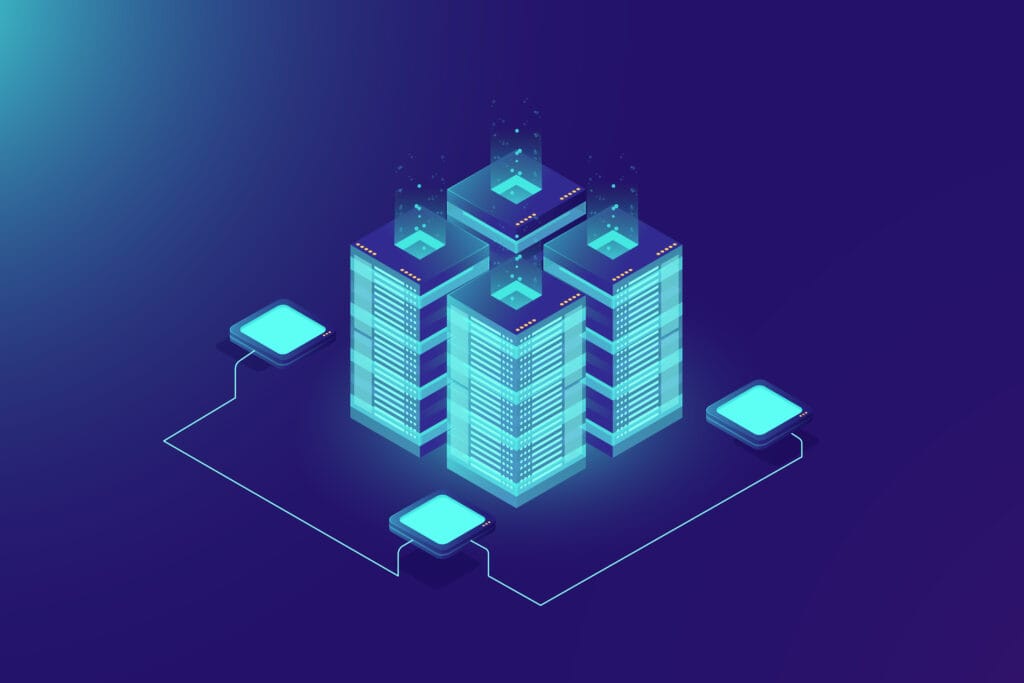Blockchain – a term that was known to a handful of enthusiasts a decade ago, today is one of the most talked about topics in the IT world. It is not only the basis for the operation of cryptocurrencies, but also an innovation that changes the way we store data, conclude contracts and manage supply chains. But what exactly is blockchain? How does it work and why does its potential go far beyond finance? Let’s take a closer look at this revolutionary technology.

Blockchain – what is it?
Blockchain, literally translated as “chain of blocks,” is a distributed database that records information in a permanent, transparent, and tamper-proof manner. Unlike traditional databases, blockchain operates on the principle of decentralization—data is stored simultaneously on many computers in the network, eliminating the need for a central administrator.
The basic feature of blockchain is that information is stored in blocks that connect in chronological order, creating an immutable chain. Once a block is saved and “sealed” cryptographically, its content becomes uneditable. It is thanks to this feature that blockchain is so valued in applications that require a high level of security and trust—from storing financial transactions, through medical records, to voting systems.
How does blockchain work?
Działanie blockchaina opiera się na kilku kluczowych elementach: zdecentralizowanej sieci, kryptografii i konsensusie. Sieć składa się z węzłów (komputerów), które komunikują się ze sobą, tworząc rozproszony system przechowywania danych. Kiedy użytkownik inicjuje transakcję, np. przesyłając kryptowalutę, informacja o niej trafia do wszystkich węzłów.
Kolejny krok to proces walidacji – w zależności od mechanizmu konsensusu, np. Proof of Work (PoW) czy Proof of Stake (PoS), węzły muszą uzgodnić, czy dana transakcja jest poprawna. Po zatwierdzeniu, transakcja zostaje dodana do bloku, który następnie jest „zamykany” za pomocą zaawansowanych algorytmów kryptograficznych. Blok staje się częścią łańcucha, a jego zawartość jest nieodwracalna – każda próba zmiany wymagałaby modyfikacji wszystkich wcześniejszych bloków, co jest praktycznie niemożliwe przy dużych sieciach. Nie potrzebuje dodatkowych kosztów czy pośredników.
Dzięki swojej przejrzystości i odporności na manipulacje blockchain rewolucjonizuje branże, w których kluczowe są bezpieczeństwo, wiarygodność i automatyzacja. To właśnie ta technologia stoi za sukcesem kryptowalut, ale także wkracza na obszary takie jak logistyka, medycyna czy sztuczna inteligencja.
Applications of blockchain technology in various industries
Now that we know what Blockchain is, let’s explain how it’s changing the rules of the game in many sectors. Blockchain applications include not only cryptocurrencies, but also supply chain management, healthcare data protection, voting systems, and digital identity, revolutionizing many sectors of the economy.
In finance, it enables lightning-fast and secure transactions, eliminating intermediaries. In logistics, it allows products to be tracked at every stage of the supply chain, increasing transparency.
In healthcare, blockchain is used to store medical data, giving patients control over their medical history. Furthermore, this technology is used in voting systems, reducing the risk of fraud, and in the energy industry, where it supports peer-to-peer energy trading.
Advantages and disadvantages of blockchain technology
The main advantages of blockchain are decentralization, security, and transparency. The lack of a central manager reduces the risk of failure or manipulation, and encryption ensures data protection. Blockchain provides reliable, shared data that strengthens trust between parties cooperating within the framework of common interests. Blockchain technology revolutionizes IT services, offering secure and transparent solutions for data management and automation of business processes.
On the other hand, the disadvantages are primarily the high cost of energy (especially with the Proof of Work mechanism), limited scalability, and the complicated implementation process. For many companies, the lack of appropriate legal regulations is also an obstacle.
The future and development of blockchain technology
Blockchain has huge potential. With the development of technologies such as the Internet of Things (IoT) or artificial intelligence, blockchain can become the basis for more advanced systems, such as smart cities or autonomous vehicles. In the near future, improvements related to energy efficiency and network scalability will be key, as well as the development of blockchain technology in the private and hybrid model.
What are the four types of blockchain networks?
There are four main types of blockchains:
- Public – open to everyone, e.g. Bitcoin.
- Private – controlled by a single organization.
- Consortium – managed by a group of companies or institutions.
- Hybrid – combining the features of public and private networks.
Public networks, such as Bitcoin, are open to everyone and provide full decentralization. Private networks, e.g. Hyperledger, operate in a closed environment with controlled access. Consortium blockchains combine features of both models, allowing groups of companies to share resources. Hybrid networks combine different approaches, offering flexibility and adaptation to the specific needs of users.
FAQs:
What are the benefits of using blockchain?
Blockchain increases transparency, eliminates intermediaries, reduces operational costs and ensures a high level of data security.
Why is blockchain the technology of the future?
Blockchain is revolutionizing the way data is managed, automating processes and introducing new opportunities in many industries, such as finance, logistics and medicine.
Is blockchain secure?
Yes, blockchain is considered very secure due to its decentralization and cryptography that protect data from manipulation.
Can blockchain be used beyond cryptocurrencies?
Of course! Blockchain is used in logistics, medicine, voting systems, as well as data management and smart contracts.
Can blockchain replace traditional databases?
Not always. Blockchain works well where transparency, decentralization, and data immutability are important, but it is not a perfect solution for all applications.
Is blockchain eco-friendly?
Traditional Proof of Work uses a lot of energy, but newer mechanisms like Proof of Stake are more environmentally friendly.
